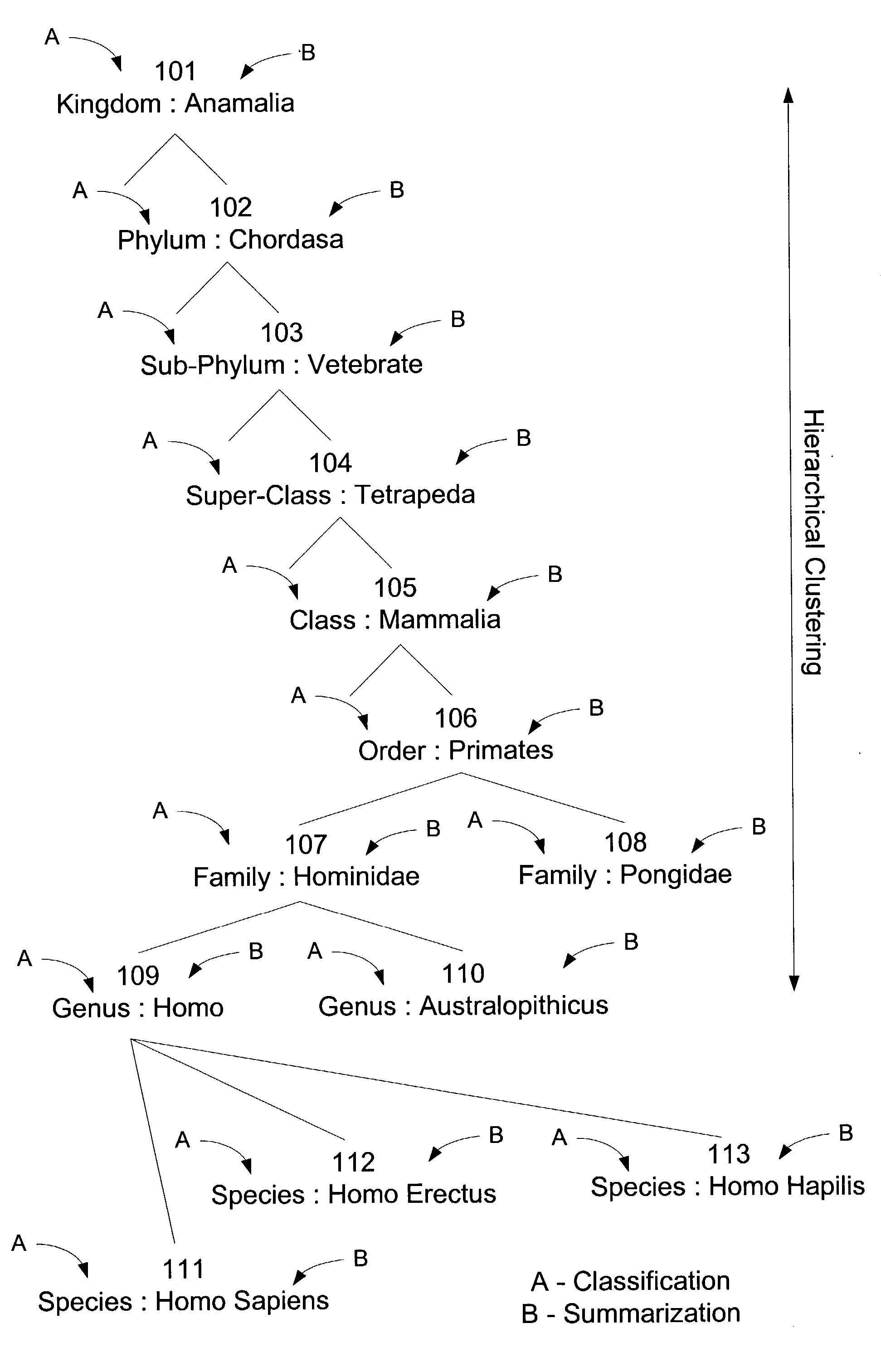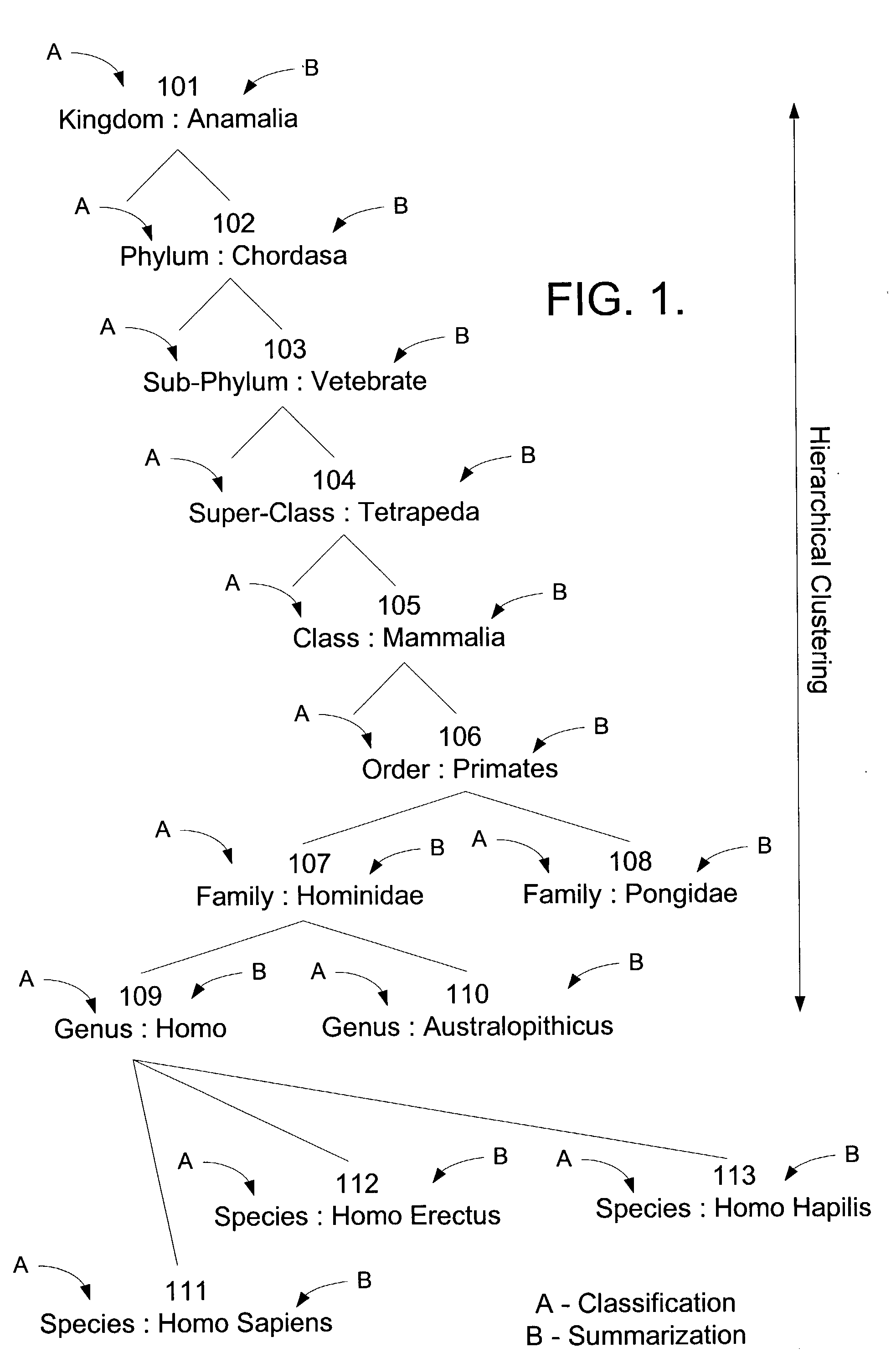Method for clustering automation and classification techniques
a technology of automatic classification and clustering, applied in the field of information retrieval system, can solve the problems of increasing the difficulty of navigation through the ever-increasing number of informational items, the size of a database becomes very large, and the need for a considerable investment of time and effort, and achieves the effect of enhancing the process of automated classification
- Summary
- Abstract
- Description
- Claims
- Application Information
AI Technical Summary
Benefits of technology
Problems solved by technology
Method used
Image
Examples
example 2
[0038] 0: Pongidae (1), Homo Sapiens (30), Homo Erectus (3), Homo Habilis (7), Australopithicus (15)
[0039] 1: Homo Sapiens (30), Homo Erectus (3), Homo Habilis (7), Australopithicus (15)
[0040] 2: Homo Sapiens (30), Homo Erectus (3), Homo Habilis (7)
[0041] Based on this artificial example, Homo Sapiens has the highest usage in the clustered documents, followed in order by Australopithicus, Homo Habilis, Homo Erectus, and finally Pongidae. Ranking scores will thus be assigned to reflect the usage of the terms within the clustered documents.
[0042] The process of taking new information and sorting the information into a set of identified categories is known as classification. Classification algorithms perform in many different ways, with the better ones being those that place new information into categories easily understood by humans. An existing classification algorithm of this type is RIPPER. RIPPER works by building a series of logic conditions on the available features of a data se...
example 3
[0044] This example shows the subsection of rules within the Order: Primates cluster (i.e., FIG. 1 cluster 106):
[0045] If DOCUMENT contains "Homo Sapiens" OR "Homo Erectus" OR "Homo Habilis" OR "Australopithicus" then
[0046] {
[0047] Place DOCUMENT in: Family Hominidae
[0048] If DOCUMENT contains "Homo Sapiens" OR "Homo Erectus" OR "Homo Habilis" then
[0049] {
[0050] Place DOCUMENT in: Genus Homo
[0051] }
[0052] else if DOCUMENT contains "Australopithicus" then
[0053] {
[0054] Place DOCUMENT in: Genus Australopithicus
[0055] }
[0056] }
[0057] else if DOCUMENT contains "Pongidae" then
[0058] {
[0059] Place DOCUMENT in: Family Pongidae
[0060] }
[0061] In a further embodiment of the present invention, the pruning aspect of a standard RIPPER algorithm is applied to the hierarchically modified RIPPER / BIRCH combination resulting in a succinct summary of the items matching a classification rule. As such, a modification to the rules, shown above in Example 3, is warranted, wherein the rules are shortened t...
example 4
[0062] If DOCUMENT contains "Homo" OR "Australopithicus" then
[0063] {
[0064] Place DOCUMENT in: Family Hominidae
[0065] If DOCUMENT contains "Homo" then
[0066] {
[0067] Place DOCUMENT in: Genus Homo
[0068] }
[0069] else if DOCUMENT contains "Australopithicus" then
[0070] {
[0071] Place DOCUMENT in: Genus Australopithicus
[0072] }
[0073] }
[0074] else if DOCUMENT contains "Pongidae" then
[0075] {
[0076] Place DOCUMENT in: Family Pongidae
[0077] }
[0078] Those skilled in the art will recognize that some new data may not match any of the rules generated by this approach. Depending on the desired implementation, these items could fall into a "catch-all" category or be placed into any of the existing categories arbitrarily and would still be considered within the scope of this invention.
[0079] Another embodiment of this invention provides a subject data store in a more human readable format than the standard ordered lists that are so common with existing search engines. This embodiment of the invention...
PUM
 Login to View More
Login to View More Abstract
Description
Claims
Application Information
 Login to View More
Login to View More - R&D
- Intellectual Property
- Life Sciences
- Materials
- Tech Scout
- Unparalleled Data Quality
- Higher Quality Content
- 60% Fewer Hallucinations
Browse by: Latest US Patents, China's latest patents, Technical Efficacy Thesaurus, Application Domain, Technology Topic, Popular Technical Reports.
© 2025 PatSnap. All rights reserved.Legal|Privacy policy|Modern Slavery Act Transparency Statement|Sitemap|About US| Contact US: help@patsnap.com



